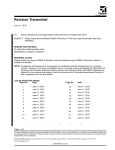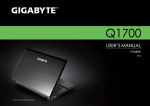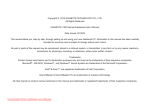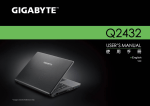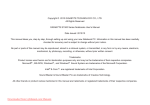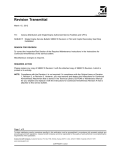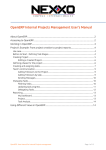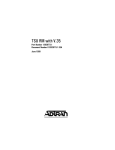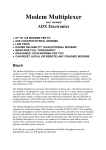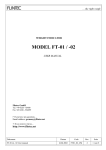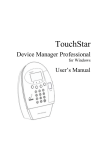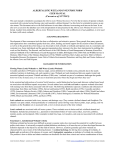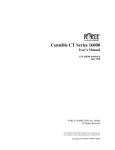Download Content - GIGABYTE
Transcript
Copyright © 2011 GIGABYTE TECHNOLOGY CO., LTD. All Rights Reserved GIGABYTE All-in-one A1840 Series User’s Manual Date Issued: 2011/06 This manual takes you, step by step, through setting up and using your new All-in-one PC. Information in this manual has been carefully checked for accuracy and is subject to change without prior notice. No part or parts of this manual may be reproduced, stored in a retrieval system, or transmitted, in any form or by any means, electronic, mechanical, by photocopy, recording, or otherwise, without prior written consent. Trademarks Product names used herein are for identication purposes only and may be the trademarks of their respective companies. Microsoft® and Windows® are trademarks of the Microsoft Corporation. Intel® is the registered trademarks of Intel Corporation. All other brands or product names mentioned in this manual are trademarks or registered trademarks of their respective companies. English I General Safety Precautions In order to ensure your safety and the safety of your computer, we ask you to carefully follow these safety precautions. ● After removing the computer from the box, please ensure that all packaging materials are kept out of the reach of small children as they can cause a potential choking hazard. The packaging materials should be safely stored away in the event that it may be used again for safe transportation of the computer. ● Ensure that the AC Adapter and power cable are placed in a safe area where it cannot be tripped over or stepped on. The AC Adapter should be situated in a well ventilated area and should have nothing resting on or covering it. ● Before turning on the computer, ensure that it is placed on a level surface with at least 10 cm of clearance around the air vents, which will aid in proper cooling. ● Do not obstruct the air vents of the computer and do not insert any foreign objects into this space. Doing this may cause a short circuit or may cause the CPU fan to malfunction, resulting in the risk of a fire or electric shock. This may eventually render permanent damage to the computer. ● Do note press or touch the display panel. ● Only use the AC Adapter that is provided with the computer or that which is recommended by the manufacturer. Using nonrecommended or non-approved parts may cause damage or increase the risk of a fire or explosion. In the event that another AC Adapter is required, advice should be sought from a GIGABYTE service agent, in order to make sure that the correct part is recommended. ● Before connecting the computer to the power outlet, make sure that the voltage rating of the AC Adapter is compatible with the power specification in the country where you are located. A detailed list of the power specification for different countries can be found on Page 21~24. ● When using an extension cord, please make sure that the total sum of ampere ratings for all connected devices does not exceed the total ampere capacity for the circuit. ● Never attempt to repair or service the computer yourself. Please refer all repairs and services to qualified service personnel at a GIGABYTE Authorized Service Center. Usage Tips ● When unplugging the power connector from the computer, please hold and pull on the connector or the strain relief loop to disconnect. Do not pull the power cord itself as this can cause damage to the cable or the computer. ● In the event of an electrical storm, please disconnect the computer from the power source and unplug any network or telephone cables that may be connected to the computer. ● Do not use the computer near water sources, like bathtubs, washing basins, kitchen or laundry sinks or swimming pools. Liquid that can spill onto the computer by accident can cause electric shock to you and damage to the computer. A1840 SERIES USER’S MANUAL When cleaning the computer, please make sure that the computer is switched off. Computer Cover: Use a microfiber or lint free soft cotton cloth and kitchen detergent (mix 5 parts water to 1 part detergent). ● Wet the cloth and wring out all excess liquid and wipe the surfaces clean. ● Take extra care to make sure that the cloth is damp and not very wet, especially when cleaning around the air vents and other openings as too much liquid in the cloth could drip onto the external components causing damage to the computer. LCD: ● It is best to use a microfiber cloth to clean the surface of the LCD. ● If there are any marks or stains present, it would be wise to use commercially available LCD cleaning kit. When using a commercially available LCD cleaning kit, never spray the liquid directly onto the screen. You must spray it onto the cleaning cloth and then wipe the screen clean. ● If this is not available then you can mix 50% isopropyl alcohol and 50% distilled water to clean the surface of the LCD screen. ● Dip the lint free soft cotton cloth into the solution, wringing out excess liquid. ● The cloth must be damp but not dripping with liquid. ● Take care not to let any excess liquid drip into the computer. ● Start from the top of the LCD surface and wipe from side to side. ● Continue with this until the entire LCD surface has been cleaned. ● Wipe the display with a clean, dry lint free soft cotton or microfiber cloth. ● Wait for the LCD surface to dry completely and then close the lid. Be careful when using Isopropyl Alcohol as this is a flammable liquid. Please keep away from children, naked flames or a computer that is switched on. English Cleaning Tips II English III Warranty Guidelines All warranty repairs and service must be carried out by a GIGABYTE Authorized Repair Centre. GIGABYTE Limited Warranty GIGABYTE warrants, that the GIGABYTE branded All-in-one PC is free of any defects in materials and workmanship under normal use during the warranty period. ● All GIGABYTE supplied AC adapters carry a 1 year limited warranty. ● The warranty is effective from date of purchase. ● If proof of purchase cannot be shown, then the warranty will be determined based on the date of manufacture. ● The limited warranty is only valid for GIGABYTE branded or supplied hardware. ● In the event that a defect arises in materials or workmanship and proof is shown of this defect, GIGABYTE will, through its authorized service provider or partner, repair the product at no extra charge, using new or refurbished replacement parts in order to fulfill the warranty obligations. ● If, during the warranty period, GIGABYTE or its service provider is unable to repair the product, the product will be replaced with a comparable product that is new or refurbished. Warranty Limitations The GIGABYTE Limited Warranty does not cover the following. ● Software, including the operating system and applications supplied with the product. This also includes third party software that may be installed after purchase. ● Third party hardware, products and accessories not supplied by GIGABYTE. This also includes third party hardware that may be bundled with the computer. ● Products with missing or defaced labels and/or serial numbers ● Products damaged by environmental factors, which include oxidation ● Products damaged by natural disasters or acts of God. ● Physical Damages which include, but not limited to, the following: ►Unauthorized modifications, repairs or servicing ►Misuse, abuse, neglect or failure to follow instructions in the user manual. ►Improper assembly ►Damages caused by transport due to improper packaging or mishandling by the courier company unless transport is part of the warranty conditions in certain countries. ►Electric damage resulting from faulty or failed electric power or power surges. ►Damaged or cracked components ►Liquid damage A1840 SERIES USER’S MANUAL Federal Communications Commission Notice. This equipment has been tested and found to comply with the limits for a Class B digital service, pursuant to Part 15 of the FCC rules. These limits are designed to provide reasonable protection against harmful interference in a residential installation. Any changes or modifications made to this equipment may void the user’s authority to operate this equipment. This equipment generates, uses, and can radiate radio frequency energy and, if not installed and used in accordance with the instructions, may cause harmful interference to radio communications. However, there is no guarantee that interference will not occur in a particular installation. If this equipment does cause harmful interference to radio or television reception, which can be determined by turning the equipment off and on, the user is encouraged to try to correct the interference by one or more of the following measures: ● Reorient or relocate the receiving antenna. ● Increase the separation between the equipment and receiver. ● Connect the equipment into an outlet on a circuit different from that to which the receiver is connected. ● Consult the dealer or an experienced radio/TV technician for help. ● All external cables connecting to this basic unit must be shielded. For cables connecting to PCMCIA cards, see the option manual or installation instructions. RF Exposure Caution: The use of a shielded-type power cord is required in order to meet FCC emission limits and to prevent interference to the nearby radio and television reception. It is essential that only the supplied power cord be used. Use only shielded cables to connect I/O devices to this equipment. You are cautioned that changes or modifications not expressly approved by the party responsible for compliance could void your authority to operate the equipment. (Reprinted from the Code of Federal Regulations #47, part 15.193, 1993. Washington DC: Office of the Federal Register, National Archives and Records Administration, U.S. Government Printing Office.) FCC Radio Frequency (RF) Exposure Caution Statement This equipment complies with FCC RF exposure limits set forth for an uncontrolled environment. To maintain compliance with FCC RF exposure compliance requirements, please follow operation instructions in the user guide. This equipment is for operation within 5.15 GHz and 5.25 GHz frequency ranges and is restricted to indoor environments only. Caution: Any changes or modifications not expressly approved by the party responsible for compliance could void the user’s authority to operate this equipment. “The manufacturer declares that this device is limited to Channels 1 through 11 in the 2.4GHz frequency by specified firmware controlled in the USA.” English Regulatory Notices & Certifications IV English V FCC RF Exposure Guidelines (Wireless Clients) This device has been tested for compliance with FCC RF Exposure (SAR) limits in typical portable configurations. In order to comply with SAR imits established in the ANSI C95.1 standards, it is recommended when using a wireless LAN adapter that the integrated antenna is positioned more than [20cm] from your body or nearby persons during extended periods of operation. If the antenna is positioned less than [20cm] from the user, it is recommended that the user limit the exposure time. R&TTE Directive (1999/5/EC) The following items were completed and are considered relevant and sufficient for the R&TTE (Radio & Telecommunications Terminal Equipment) directive: ● Essential requirements as in [Article 3] ● Protection requirements for health and safety as in [Article 3.1a] ● Testing for electric safety according to [EN 60950] ● Protection requirements for electromagnetic compatibility in [Article 3.1b] ● Testing for electromagnetic compatibility in [EN 301 489-1] & [EN 301] ● Testing according to [489-17] ● Effective use of the radio spectrum as in [Article 3.2] ● Radio test suites according to [EN 300 328-2] CE Notice (European Union) This symbol indicates this All-in-one PC A1840 complies with the EMC Directive and the European Union’s Low Voltage Directive. This symbol also indicates that A1840 meets the following technical standards: ● EN 55022 — “Limitations and Methods of Measurement for the Radio Interferences of Information Technology Equipment.” ● EN 55024 — “Information technology equipment - Immunity characteristics - Limits and methods of measurement.” ● EN 61000-3-2 — “Electromagnetic compatibility (EMC) - Chapter 3: Limits - Section 2: Limits on the harmonic current emissions (Equipment input current up to and including 16 A per phase).” ● EN 61000-3-3 — “Electromagnetic compatibility (EMC) - Chapter 3: Limits - Section 3: Limits on the voltage fluctuations and flicker in low-voltage power supply systems for equipment with rate current up to and including 16 A.” NOTE: EN 55022 emissions requirements provide for two classifications ●Class A governs commercial use ●Class B is governs residential use BSMI Notice (Taiwan Only) ● The symbol above must be attached to the product indicating compliancewith the BSMI standard. ● Note: The maximum operating temperature is 35℃ A1840 SERIES USER’S MANUAL English VI Introduction Congratulations and thank you for purchasing the GIGABYTE A1840 computer. This A1840 computer provides excellent multimedia functionality and is designed to provide you reliable, no fuss computing. This manual will explain to you, step by step, how to setup and begin using your A1840. It provides basic configuring, operation, care and troubleshooting guidelines. English VII Content General Safety Precautions............................................................... I Usage Tips.........................................................................................I Cleaning Tips....................................................................................II Warranty Guidelines......................................................................... III Regulatory Notices & Certifications..................................................IV Introduction.......................................................................................VI Chapter 1 Before You Start 1.1 Make Sure You Have Everything.............................................. 2 1.2 Familiarize Yourself with the Computer.................................... 2 1.3 Top View...................................................................................3 1.4 Left View...................................................................................4 1.5 Right View.................................................................................5 1.6 Bottom View..............................................................................6 Chapter 2 Getting Started 2.1 Power Sources..........................................................................8 2.2 Upgrading Your A1840............................................................. 9 Chapter 3 GIGABYTE Smart Recovery 3.1 GIGABYTE Smart Recovery................................................... 14 Chapter 4 Troubleshooting 4.1 Identifying the Problem........................................................... 16 4.2 GIGABYTE Service Information.............................................. 17 Appendix A1840 Specifications.......................................................................20 International Country Voltage.......................................................... 21 A1840 SERIES USER’S MANUAL English 1 Chapter 1 Before You Start This chapter provides basic information to help you get started and to use the A1840. English 2 1.1 Make Sure You Have Everything When you receive your all-in-one PC, unpack it carefully and check to make sure you have all the items listed below. For a pre-configured model you should have the following: ● GIGABYTE A1840 All-in-one PC ● AC Adapter with Power Cord ● Driver Disc ● User Manual ● Keyboard(optional) ● Mouse(optional) Once you have checked and confirmed that your computer system is complete, read through the following pages to learn about all of your A1840 components. NOTE: Depending on the model you purchased, the actual appearance of your computer may vary from that shown in this manual.These images are for illustration purposes. 1. Gently lay the screen face down on a flat clean padded surface. 2. Pull the computer stand till it reaches the first detent stop. (approximately 10° apart from the rear of the computer). 3. Lift the computer carefully and adjust the angle of the screen. Please ensure the computer stand has been pulled up to the first detent position, so that your computer may stand firm and upNon-Touch Screen right. 1.2 Familiarize Yourself with the A1840 Preparing To Setup Your computer Before attempting to set up your computer, to protect the computer and monitor, you should: • find a flat open area on your desk to position your computer. • place a soft item like the computer packaging bag on the desk for padding. It is suggested to install your computer in a space that allows for airflow as restrictingthe airflow may cause overheating which could impact the performance of your computer. Now you are ready to access some ports on the rear panel of the computer to make cable connections. A1840 SERIES USER’S MANUAL The following is an overview of the front of the computer. 1 NO. Item 2 Microphone The built-in microphone allows for the reception and transmission of voice and/or other audio data to any program capable of utilizing the microphone. Webcam The built-in 1.3 mega pixel camera with 1 digital microphone allows you to snap a photo or create a video or hold a video conference or chat with just a click. 3 Speakers The built-in stereo speaker system allows you to hear audio without additional attachments. The multimedia sound system features an integrated digital audio controller that produces rich and vibrant sound. 4 HDD Status Indicator Light The Hard Disk Drive (HDD) Status indicator tells you whether your internal hard drive is being accessed. 5 Hotkey for LCD Brightness control. Press to Brightness Decrease Button decrease brightness. 6 Power On Button This button turns your computer on and off. 7 Brightness Increase Button 8 whether your computer is connected to a Wireless LAN Activity Indicator wireless network or not. • Blue light on indicates an active LAN or Light 1 2 3 8 7 6 5 4 Function Hotkey for LCD Brightness control. Press to increase brightness. The Wireless LAN Status Indicator tells you Wireless LAN. English 1.3 Front View 3 English 1.4 Left View The following is a brief description of the left side of the computer. 4 1 3 5 7 NO. Item 1 Audio Input Jack Connect to an audio out jack on external audio equipment for audio sound. 2 SPDIF Out Connect to a SPDIF digital audio input on certain expansion cards. USB 3.0 Ports The USB port allows many devices to run simultaneously. It supports hot-swapping of devices so that most peripherals can be connected or disconnected without restarting the computer. USB 2.0 Ports The USB port allows many devices to run simultaneously. It supports hot-swapping of devices so that most peripherals can be connected or disconnected without restarting the computer. 5 HDMI Port The HDMI port allows you to connect a video device such as an HD television, projector, or HD display to your computer for outputing a high definition signal. 6 LAN(RJ-45) Port The LAN port is designed to support a 10/100/1000 Base-T standard RJ-45 plug. 7 DC in Jack The DC in JACK port allows you to plug in the AC adapter to power your computer. Only use certified AC adaptors. 2 4 Function 3 6 4 A1840 SERIES USER’S MANUAL The following is a brief description of the left side of the computer. NO. Item Optical Disc Drive The memory card reader offers the fastest and most convenient method to transfer pictures, music and data between your computer and flash compatible devices such as digital cameras, MP3 players, mobile phones, and PDAs. 2 Multi Card Reader The USB port allows many devices to run simultaneously. It supports hot-swapping of devices so that most peripherals can be connected or disconnected without restarting the computer. 3 The USB port allows many devices to run simultaneously. It supports hot-swapping USB 2.0 Ports of devices so that most peripherals can be connected or disconnected without restarting the computer. 4 Microphone Jack The microphone jack allows you to connect an external microphone. 5 Headphone Jack The headphone jack allows you to connect headphones or external speakers and amplifiers. 1 1 2 4 Function 3 5 English 1.5 Right View 5 English 1.6 Rear View The following is an overview of the rear of the computer. NO. Item 2 1 6 2 1 2 Function Kensington Lock Slot The Kensington lock slot allows you to secure your computer to an immovable object with an optional security cable. Cooling Vents These are open vents for the fan to dissipate heat from the computer's internal components. Do not block these or place the computer in such a position that you inadvertently allow the outlets to become blocked. Do not cover the vents or place any object into or over the vents. A1840 SERIES USER’S MANUAL English 7 Chapter 2 Getting Started This chapter will help you familiarize with all-in-one PC A1840. Certain parts of the all-in-one PC can be user upgraded while others are fixed and cannot be changed. English 8 2.1 Power Sources Your computer has the power sources: AC adapter. Connecting the Power Adapters : The AC adapter provides power for operating your computer. Connecting the AC Adapter : It is recommended that only the AC adapter supplied with the A1840 is used. Any other adapter could cause damage or malfunction and might result in injury. 3 2 1 1. Connect the power cord to the AC adapter. 2. Connect the AC adapter to the DC power port of your computer. 3. Connect the AC adapter power cord to an AC outlet. Switching on the Power: The power indicator will be illuminated when the power is switched on. After you turn on the A1840 for the very first time, do not turn it off until the operating system has been configured. Please note that the volume for the audio will not function until Windows Setup has completed. Booting Up the A1840 for the First Time: Depending on your configuration, the Microsoft Windows Boot Screen will be the first screen that you will see as the computer starts up. Follow the on-screen prompts and instructions and enter your personal information to complete the setup of the Windows Operating System. A1840 SERIES USER’S MANUAL Safety Measures: Computer and electronic circuit boards can be damaged by discharges of static electricity. Working on computers that are still connected to a power supply can be extremely dangerous. Follow the simple guidelines below to avoid damage to your computer or injury to yourself. • Always disconnect the computer from the power outlet whenever you are working inside the computer case. • Hold electronic circuit boards by the edges only. Do not touch the components on the board unless it is necessary to do so. Do not flex or stress the circuit board. • Leave all components inside the static-proof packaging until you are ready to use the component for the installation. 2. Remove the back cover from the system. English 2.2 Upgrading Your A1840 9 1.Loosen and remove the screws securing the back cover. Recommend to upgrade the hard drive and memory by the professional and technical person. English 10 Replacing Hard Disk Drive: Before installing remove or install the HDD, adhere to the following cautions: • Take note of the drive tray orientation before sliding it out. • The tray will not fit back into the bay if inserted incorrectly. 3. Loosen and remove the screws securing the motherboard metal cover. Follow these instructions to install the hard disk drive: 1.Loosen and remove the screws securing the HDD bracket. Recommend to upgrade the hard drive and memory by the professional and technical person. 2.Loosen the four screws. A1840 SERIES USER’S MANUAL Before installing a memory module, make sure to turn off the computer and unplug the power cord from the power outlet to prevent damage to the memory module. Follow these instructions to install the memory: ● Align the memory with the DIMM module and insert the DIMM memory module into the DIMM slot. Please note that memory module has a foolproof insertion design. A memory module can be installed In only one direction. ● Push down the memory and seat it firmly. ● Reverse the installation steps when you wish to remove the DIMM module. Recommend to upgrade the hard drive and memory by the professional and technical person. English Installing Memory: 11 English 12 A1840 SERIES USER’S MANUAL English 13 Chapter 3 GIGABYTE Smart Recovery English 14 3.1 GIGABYTE Smart Recovery System Recovery - Restore your A1840 operating system. The hard drive of the A1840 has a hidden partition that contains a full backup image of the operating system that can be used to recover the system in the event that something happens to the operating system. If the hard drive is removed or the partition deleted, the recover options will no longer be available and a recovery service will be needed. Launch System Recovery: The system recover feature is part of the netbook installation and it ships preset from the factory. The options menu allows you to launch the Windows recovery tool to reinstall the operating system to factory defaults. Below will briefly describe how to launch the recovery tool and to get the recovery started. 3.T he recovery window will open and give you the option to "Recovery" in the toolbar. You will be prompted if you want to recovery. Click on "Recovery" to begin the repair if you do. 4.T he "Recovering" window will open and begin the recovery. 5.O n c e i t i s c o m p l e t e y o u w i l l b e prompted to reboot the computer. 1.Turn off or restart the netbook. 2.Turn the netbook on and press and hold the F9 key to launch the tool. Please be noted that the GIGABYTE Smart Recovery interface, icons, utilities and software versions may vary based on the purchased models. Please operate GIGABYTE Smart Recovery according to the default built-in version. A1840 SERIES USER’S MANUAL English 15 Chapter 4 Troubleshooting This section will briefly cover some frequently encountered problems and questions and provide a quick guide to assist with solve these problems. Most problems can be resolved quickly, simply and easily and are not always a system problem. Should you encounter a problem that is not yet or differently listed, please consult the GIGABYTE website or call your unit supplier for assistance. For website assistance go to the Support section of www.gigabyte. com for telephonic assistance please call the supplier of your unit or take the unit to the supplier directly for assistance. English 16 4.1 Identifying the Problem Q1.I have pressed the Power button, but my computer cannot start up. ● Check the power cable and power adapter are connected. ● Check the Power button indicator. ►If the indicator does not light up, your computer is not being supplied power from an external power source via the power adapter. Check the connection between your computer, the power adapter, and the nearby outlet. ►If the indicator flashes in white, your computer has entered Sleep mode. Move your mouse or click any button on the keyboard to wake the system. ►If the Power button indicator lights up in white, the computer is being supplied normally with power. Reconnect the power adapter and restart the system. ● Certain operating system files may be damaged or missing. If so, you have to back up all your data first, and then recover your system. Check the supplied driver disc for details. Q2.My computer cannot access a modem or a wireless router or access point. ● Verify that you have performed a correct pre-installation for your Internet connection type. ►If you are using a wireless Internet connection, make sure that your computer has installed a wireless LAN card in order to connect with a wireless router or access point.For details about setting up your wireless router or access point, refer to the documentation or user manual of the unit.For details about setting up your modem, contact your ISP (Internet service provider) for assistance. ►If you are using a wired Internet connection, make sure that your computer is using an Ethernet cable, instead of a tele-phone cable, to connect with the broadband modem which is purchased from your ISP. For assistance setting up your modem, contact your ISP. Q3.The wireless Internet connection is unstable. ● Check the wireless interference. ►Reset your wireless router or access point to factory defaults and reconfigure the settings. ►Update the firmware of your wireless router or access point to the latest version available on the manufacturer’s site. Try moving the wireless router or access point in a central position. A couple of feet will sometimes make a big difference in signal strength. ►If you are using an access point, try changing the channel, as another access point may be interfering. ►Contact your ISP to ensure they are not experiencing technical problems. Q4.There is nothing visible on the screen. ● Check the power cable and power adapter are well connected. ● Check the Power button indicator. ►If the indicator does not light up, your computer is not being supplied power from an external power source via the power adapter. Check the connection between your computer, the power adapter, and the nearby outlet. ►If the indicator flashes in white, your computer has entered Sleep mode. Move your mouse or click any button on the keyboard to wake the system. A1840 SERIES USER’S MANUAL Q5.The images on the screen are too large or too small, or the images are blurred. ● Check if the monitor is running at its native resolution. ►Right clickthe desktop, and then select Screen Resolution. In the prompted window, set the Resolution to 1366 x 768, and then click Apply and OK to complete the settings. Q6.Certain audio files cannot be played, and the Codec error messages appear. ● Check if Windows Media Player is set to automatically download codecs. ►Right click on the menu bar, select Tools from the opened menu, and then click Options. On the Player tab, in the Automatic updates area, select Once a day, and then click Apply and OK to complete the settings. Then try playing the file again. If the audio file still cannot be played, it might require a codec that is not supported by Windows Media Player. For more information about available codecs, see the documentation for Windows Media Player at the Microsoft web site. More service information please link to GIGABYTE official website: www.gigabyte.com English 4.2 GIGABYTE Service Information ►If the Power button indicator lights up in white, the computer is being supplied normally with power. Reconnect the power adapter and restart the system. ►Check if the brightness level of the display is adjusted correctly, and is not set too low or too high. Use the Brightness control by pressing the Brightness/ Increase/Decrease buttons on the front panel to adjust the brightness level. 17 English 18 A1840 SERIES USER’S MANUAL English 19 Appendix English 20 A1840 Specifications SKU Type A1840 CPU 2nd Generation Intel Core™ i3/ i5/ i7 Processor Family / Intel® Pentium® Processor Operation System Genuine Windows® 7 Home Premium Genuine Windows® 7 Professional LCD 18.5" 1366x768 LED backlight System Memory 2GB/4GB DDRIII, 2 slots(Max 8GB) Chipset Mobile Intel® H61 Express Chipsets Video Graphics Intel® GT2 graphics with dynamic frequency Hard Disk Drive 320/500/640GB 3.5" SATA HDD Optical Disk Drive 12.7mm Super Multi DVD RW Audio 3 Watt Speakers*2 I/O Port USB(2.0)*3, USB(3.0)*2, HDMI, D-Sub, RJ45, Mic-in, Earphone-out, 4-in-1 card reader(MS/MMC/SD/XD), DC-in jack, Audio in, SPDIF Communications LAN 10/100/1000Mbps Ethernet Base-T Wireless LAN 802.11b/g/n Wireless Bluetooth Bluetooth V3.0+HS WWAN (3.5G) N/A Webcam 1.3 Mega Pixel w/ intrnal mic-in Dimensions 456(W) x 57(D) x 366(H)mm Weight ~5.62kg Accessory Keyboard+mouse(optional) A1840 SERIES USER’S MANUAL Region Afghanistan Albania Algeria American Samoa Andorra Angola Anguilla Antigua Argentina Armenia Aruba Australia Austria Azerbaijan Azores Bahamas Bahrain Balearic Islands Bangladesh Barbados Belarus Belgium Belize Benin Bermuda Bhutan Bolivia Bonaire Bosnia Botswana Voltage 240V 220V 230V 120V 230V 220V 110V 230V 220V 230V 127V 230V 230V 220V 220V 120V 230V 220V 220V 115V 220V 230V 110V / 220V 220V 120V 230V 220V 127V 220V 231 V Frequency 50 Hz 50 Hz 50 Hz 60 Hz 50 Hz 50 Hz 60 Hz 60 Hz 50 Hz 50 Hz 60 Hz 50 Hz 50 Hz 50 Hz 50 Hz 60 Hz 50 Hz 50 Hz 50 Hz 50 Hz 50 Hz 50 Hz 60 Hz 50 Hz 60 Hz 50 Hz 50 Hz 50 Hz 50 Hz 50 Hz Region Brazil Brunei Bulgaria Burkina Faso Burundi Cambodia Cameroon Canada Canary Islands Cape Verde Cayman Islands Central African Republic Chad Channel Islands Chile China (mainland only) Colombia Comoros Congo-Brazzaville Congo-Kinshasa Cook Islands Costa Rica Côte d'Ivoire Croatia Cuba Cyprus Czech Republic Denmark Djibouti Dominica Voltage 127V / 220 V 240V 230V 220V 220V 230V 220V 120V 220V 220V 120V 220V 220V 230V 220V 220V 120V 220V 230V 220V 240V 120V 230V 230V 110V 240V 230V 230V 220V 230V Frequency 60 Hz 50 Hz 50 Hz 50 Hz 50 Hz 50 Hz 50 Hz 60 Hz 50 Hz 50 Hz 60 Hz 50 Hz 50 Hz 50 Hz 50 Hz 50 Hz 60 Hz 50 Hz 50 Hz 50 Hz 50 Hz 60 Hz 50 Hz 50 Hz 60 Hz 50 Hz 50 Hz 50 Hz 50 Hz 50 Hz English International Country Voltage 21 English 22 Region Dominican Republic East Timor Ecuador Egypt El Salvador Equatorial Guinea Eritrea Estonia Ethiopia Faroe Islands Falkland Islands Fiji Finland France French Guiana Gaza Strip Gabon Gambia Georgia Germany Ghana Gibraltar Greece Greenland Grenada Guadeloupe Guam Guatemala Guinea Guinea-Bissau Guyana Haiti Voltage 110V 220V 120V 220V 115V 220V 230V 230V 220V 220V 240V 240V 230V 230V (formerly 220V) 220V 230V 220V 230V 220V 230V (formerly 220V) 230V 240V 230V (formerly 220V) 220V 230V 230V 110V 120V 220V 220V 240V 110V Frequency 60 Hz 50 Hz 60 Hz 50 Hz 60 Hz 50 Hz 50 Hz 50 Hz 50 Hz 50 Hz 50 Hz 50 Hz 50 Hz 50 Hz 50 Hz 50 Hz 50 Hz 50 Hz 50 Hz 50 Hz 50 Hz 50 Hz 50 Hz 50 Hz 50 Hz 50 Hz 60 Hz 60 Hz 50 Hz 50 Hz 60 Hz 60 Hz Region Honduras Hong Kong Hungary Iceland India Indonesia Iran Iraq Ireland Isle of Man Israel Italy Jamaica Japan Jordan Kazakhstan Kenya Kiribati Kuwait Kyrgyzstan Laos Latvia Lebanon Lesotho Liberia Libya Lithuania Liechtenstein Luxembourg Macau S.A.R. of China Macedonia Madagascar Voltage Frequency 110V 60 Hz 220V 50 Hz 230V (formerly 220V) 50 Hz 230V 50 Hz 220V 50 Hz 127V / 230V 50 Hz 220V 50 Hz 230V 50 Hz 230V (formerly 220V) 50 Hz 240V 50 Hz 230V 50 Hz 230V (formerly 220V) 50 Hz 110V and 220V 50 Hz 100 V 50 Hz / 60Hz 230V 50 Hz 220V 50 Hz 240V 50 Hz 240V 50 Hz 240V 50 Hz 220V 50 Hz 230V 50 Hz 220V 50 Hz 240V 50 Hz 220V 50 Hz 120V / 240V 50 Hz 127V 50 Hz 230V (formerly 220V) 50 Hz 230V 50 Hz 230V (formerly 220V) 50 Hz 220V 50 Hz 220V 50 Hz 127V / 220 V 50 Hz A1840 SERIES USER’S MANUAL Madeira Malawi Malaysia Maldives Mali Malta Martinique Mauritania Mauritius Mexico Micronesia Moldova Monaco Mongolia Montenegro Montserrat (Leeward Is.) Morocco Mozambique Myanmar/Burma Namibia Nauru Nepal Netherlands Netherlands Antilles New Caledonia New Zealand Nicaragua Niger Nigeria North Korea Norway Okinawa Voltage 220V 230V 240V 230V 220V 230V 220V 220V 230V 127V 120V 220-230V 127V / 220 V 230 V 220V 230V 127V / 220 V 220V 230V 220V 240V 230V 230V (formerly 220V) 127V / 220V 220V 230V 120V 220V 240V 220V 230V 100 V Frequency 50 Hz 50 Hz 50 Hz 50 Hz 50 Hz 50 Hz 50 Hz 50 Hz 50 Hz 60 Hz 60 Hz 50 Hz 50 Hz 50 Hz 50 Hz 60 Hz 50 Hz 50 Hz 50 Hz 50 Hz 50 Hz 50 Hz 50 Hz 50 Hz 50 Hz 50 Hz 60 Hz 50 Hz 50 Hz 50 Hz 50 Hz 60 Hz Region Oman Pakistan Panama Papua New Guinea Paraguay Peru Philippines Poland Portugal Puerto Rico Qatar Réunion Romania Russian Federation Rwanda St. Kitts and Nevis St. Lucia (Winward Is.) St. Vincent (Winward Is.) São Tomé and Príncipe Saudi Arabia Senegal Serbia Seychelles Sierra Leone Singapore Slovakia Slovenia Somalia South Africa South Korea Spain Sri Lanka Voltage 240V 230V 110V 240V 220V 220V 220V 230V 220V 120V 240V 220V 230V (formerly 220V) 220V 230V 110V / 230V 240V 230V 220V 127V / 220V 230V 220V 240V 230V 230V 230V 230V 220V 220V 220V 230V (formerly 220V) 230V Frequency 50 Hz 50 Hz 60 Hz 50 Hz 50 Hz 60 Hz 60 Hz 50 Hz 50 Hz 60 Hz 50 Hz 50 Hz 50 Hz 50 Hz 50 Hz 60 Hz 50 Hz 50 Hz 50 Hz 60 Hz 50 Hz 50 Hz 50 Hz 50 Hz 50 Hz 50 Hz 50 Hz 50 Hz 50 Hz 60 Hz 50 Hz 50 Hz English Region 23 English 24 Region Sudan Suriname Swaziland Sweden Switzerland Syria Tahiti Taiwan Tajikistan Tanzania Thailand Togo Tonga Trinidad & Tobago Tunisia Turkey Turkmenistan Uganda Ukraine United Arab Emirates United Kingdom United States of America Uruguay Uzbekistan Vanuatu Venezuela Vietnam Virgin Islands Western Samoa Yemen Zambia Zimbabwe Voltage Frequency 230V 50 Hz 127V 60 Hz 230V 50 Hz 230V 50 Hz 230V 50 Hz 220V 50 Hz 110V / 220V 60 Hz / 50 Hz 110V 60 Hz 220V 50 Hz 230V 50 Hz 220V 50 Hz 220V 50 Hz 240V 50 Hz 115V 60 Hz 230V 50 Hz 230V 50 Hz 220V 50 Hz 240V 50 Hz 220V 50 Hz 220V 50 Hz 230V (formerly 240V) 50 Hz 120V 60 Hz 230V (formerly 220V) 50 Hz 220V 50 Hz 230V 50 Hz 120V 60 Hz 220V 50 Hz 110V 60 Hz 230V 50 Hz 230V 50 Hz 230V 50 Hz 220V 50 Hz

































